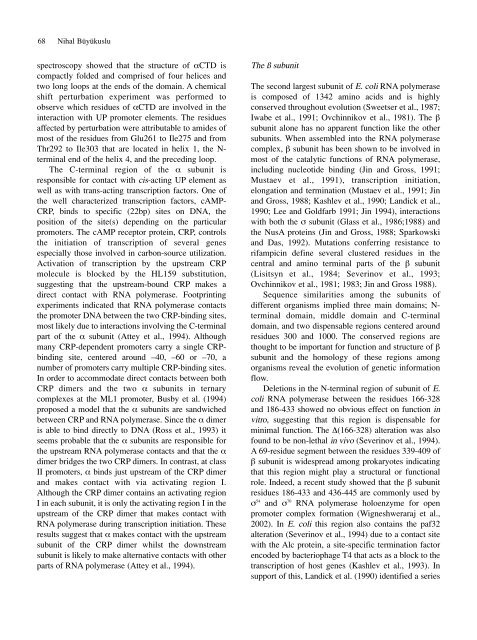(Converted)-5 - Journal of Cell and Molecular Biology - Haliç ...
(Converted)-5 - Journal of Cell and Molecular Biology - Haliç ...
(Converted)-5 - Journal of Cell and Molecular Biology - Haliç ...
Create successful ePaper yourself
Turn your PDF publications into a flip-book with our unique Google optimized e-Paper software.
68 Nihal Büyükuslu<br />
spectroscopy showed that the structure <strong>of</strong> αCTD is<br />
compactly folded <strong>and</strong> comprised <strong>of</strong> four helices <strong>and</strong><br />
two long loops at the ends <strong>of</strong> the domain. A chemical<br />
shift perturbation experiment was performed to<br />
observe which residues <strong>of</strong> αCTD are involved in the<br />
interaction with UP promoter elements. The residues<br />
affected by perturbation were attributable to amides <strong>of</strong><br />
most <strong>of</strong> the residues from Glu261 to Ile275 <strong>and</strong> from<br />
Thr292 to Ile303 that are located in helix 1, the Nterminal<br />
end <strong>of</strong> the helix 4, <strong>and</strong> the preceding loop.<br />
The C-terminal region <strong>of</strong> the α subunit is<br />
responsible for contact with cis-acting UP element as<br />
well as with trans-acting transcription factors. One <strong>of</strong><br />
the well characterized transcription factors, cAMP-<br />
CRP, binds to specific (22bp) sites on DNA, the<br />
position <strong>of</strong> the site(s) depending on the particular<br />
promoters. The cAMP receptor protein, CRP, controls<br />
the initiation <strong>of</strong> transcription <strong>of</strong> several genes<br />
especially those involved in carbon-source utilization.<br />
Activation <strong>of</strong> transcription by the upstream CRP<br />
molecule is blocked by the HL159 substitution,<br />
suggesting that the upstream-bound CRP makes a<br />
direct contact with RNA polymerase. Footprinting<br />
experiments indicated that RNA polymerase contacts<br />
the promoter DNA between the two CRP-binding sites,<br />
most likely due to interactions involving the C-terminal<br />
part <strong>of</strong> the α subunit (Attey et al., 1994). Although<br />
many CRP-dependent promoters carry a single CRPbinding<br />
site, centered around –40, –60 or –70, a<br />
number <strong>of</strong> promoters carry multiple CRP-binding sites.<br />
In order to accommodate direct contacts between both<br />
CRP dimers <strong>and</strong> the two α subunits in ternary<br />
complexes at the ML1 promoter, Busby et al. (1994)<br />
proposed a model that the α subunits are s<strong>and</strong>wiched<br />
between CRP <strong>and</strong> RNA polymerase. Since the α dimer<br />
is able to bind directly to DNA (Ross et al., 1993) it<br />
seems probable that the α subunits are responsible for<br />
the upstream RNA polymerase contacts <strong>and</strong> that the α<br />
dimer bridges the two CRP dimers. In contrast, at class<br />
II promoters, α binds just upstream <strong>of</strong> the CRP dimer<br />
<strong>and</strong> makes contact with via activating region I.<br />
Although the CRP dimer contains an activating region<br />
I in each subunit, it is only the activating region I in the<br />
upstream <strong>of</strong> the CRP dimer that makes contact with<br />
RNA polymerase during transcription initiation. These<br />
results suggest that α makes contact with the upstream<br />
subunit <strong>of</strong> the CRP dimer whilst the downstream<br />
subunit is likely to make alternative contacts with other<br />
parts <strong>of</strong> RNA polymerase (Attey et al., 1994).<br />
The ß subunit<br />
The second largest subunit <strong>of</strong> E. coli RNA polymerase<br />
is composed <strong>of</strong> 1342 amino acids <strong>and</strong> is highly<br />
conserved throughout evolution (Sweetser et al., 1987;<br />
Iwabe et al., 1991; Ovchinnikov et al., 1981). The β<br />
subunit alone has no apparent function like the other<br />
subunits. When assembled into the RNA polymerase<br />
complex, β subunit has been shown to be involved in<br />
most <strong>of</strong> the catalytic functions <strong>of</strong> RNA polymerase,<br />
including nucleotide binding (Jin <strong>and</strong> Gross, 1991;<br />
Mustaev et al., 1991), transcription initiation,<br />
elongation <strong>and</strong> termination (Mustaev et al., 1991; Jin<br />
<strong>and</strong> Gross, 1988; Kashlev et al., 1990; L<strong>and</strong>ick et al.,<br />
1990; Lee <strong>and</strong> Goldfarb 1991; Jin 1994), interactions<br />
with both the σ subunit (Glass et al., 1986;1988) <strong>and</strong><br />
the NusA proteins (Jin <strong>and</strong> Gross, 1988; Sparkowski<br />
<strong>and</strong> Das, 1992). Mutations conferring resistance to<br />
rifampicin define several clustered residues in the<br />
central <strong>and</strong> amino terminal parts <strong>of</strong> the β subunit<br />
(Lisitsyn et al., 1984; Severinov et al., 1993;<br />
Ovchinnikov et al., 1981; 1983; Jin <strong>and</strong> Gross 1988).<br />
Sequence similarities among the subunits <strong>of</strong><br />
different organisms implied three main domains; Nterminal<br />
domain, middle domain <strong>and</strong> C-terminal<br />
domain, <strong>and</strong> two dispensable regions centered around<br />
residues 300 <strong>and</strong> 1000. The conserved regions are<br />
thought to be important for function <strong>and</strong> structure <strong>of</strong> β<br />
subunit <strong>and</strong> the homology <strong>of</strong> these regions among<br />
organisms reveal the evolution <strong>of</strong> genetic information<br />
flow.<br />
Deletions in the N-terminal region <strong>of</strong> subunit <strong>of</strong> E.<br />
coli RNA polymerase between the residues 166-328<br />
<strong>and</strong> 186-433 showed no obvious effect on function in<br />
vitro, suggesting that this region is dispensable for<br />
minimal function. The ∆(166-328) alteration was also<br />
found to be non-lethal in vivo (Severinov et al., 1994).<br />
A 69-residue segment between the residues 339-409 <strong>of</strong><br />
β subunit is widespread among prokaryotes indicating<br />
that this region might play a structural or functional<br />
role. Indeed, a recent study showed that the β subunit<br />
residues 186-433 <strong>and</strong> 436-445 are commonly used by<br />
σ 54 <strong>and</strong> σ 70 RNA polymerase holoenzyme for open<br />
promoter complex formation (Wigneshweraraj et al.,<br />
2002). In E. coli this region also contains the paf32<br />
alteration (Severinov et al., 1994) due to a contact site<br />
with the Alc protein, a site-specific termination factor<br />
encoded by bacteriophage T4 that acts as a block to the<br />
transcription <strong>of</strong> host genes (Kashlev et al., 1993). In<br />
support <strong>of</strong> this, L<strong>and</strong>ick et al. (1990) identified a series

















